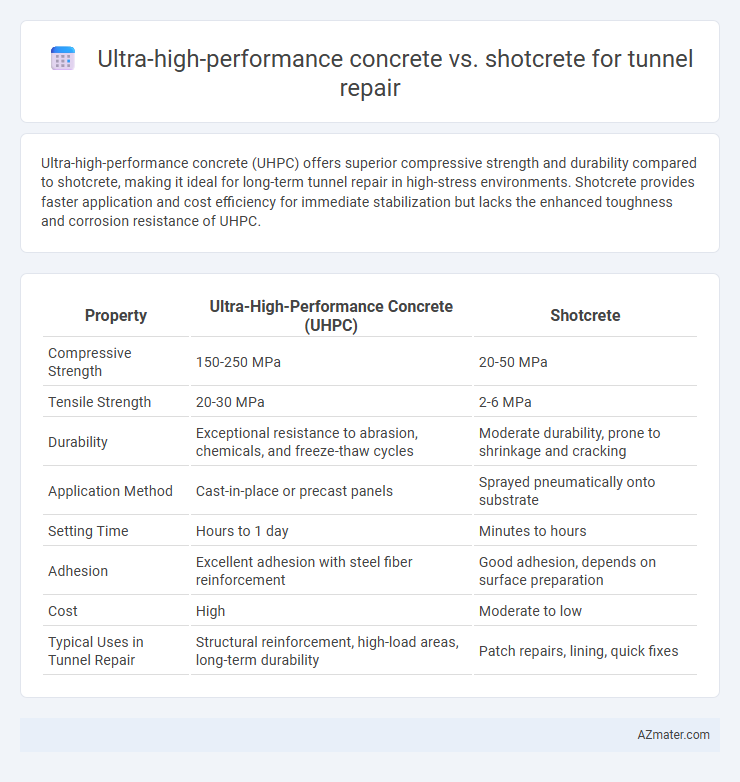Ultra-high-performance concrete (UHPC) offers superior compressive strength and durability compared to shotcrete, making it ideal for long-term tunnel repair in high-stress environments. Shotcrete provides faster application and cost efficiency for immediate stabilization but lacks the enhanced toughness and corrosion resistance of UHPC.
Table of Comparison
| Property | Ultra-High-Performance Concrete (UHPC) | Shotcrete |
|---|---|---|
| Compressive Strength | 150-250 MPa | 20-50 MPa |
| Tensile Strength | 20-30 MPa | 2-6 MPa |
| Durability | Exceptional resistance to abrasion, chemicals, and freeze-thaw cycles | Moderate durability, prone to shrinkage and cracking |
| Application Method | Cast-in-place or precast panels | Sprayed pneumatically onto substrate |
| Setting Time | Hours to 1 day | Minutes to hours |
| Adhesion | Excellent adhesion with steel fiber reinforcement | Good adhesion, depends on surface preparation |
| Cost | High | Moderate to low |
| Typical Uses in Tunnel Repair | Structural reinforcement, high-load areas, long-term durability | Patch repairs, lining, quick fixes |
Introduction to Tunnel Repair Technologies
Ultra-high-performance concrete (UHPC) offers superior compressive strength, durability, and reduced permeability compared to traditional shotcrete, making it ideal for enhancing tunnel lining resilience and extending service life. Shotcrete, a pneumatically applied concrete, ensures rapid application and excellent adhesion on irregular tunnel surfaces, facilitating efficient repair of cracks and spalling. Selecting between UHPC and shotcrete depends on repair scope, structural requirements, and environmental exposure in tunnel maintenance projects.
What Is Ultra-High-Performance Concrete (UHPC)?
Ultra-High-Performance Concrete (UHPC) is an advanced composite material characterized by its exceptional strength, durability, and impermeability, making it ideal for demanding tunnel repair applications. UHPC contains a dense matrix of fine powders, high-strength steel fibers, and a low water-to-cement ratio, enabling superior compressive strengths often exceeding 150 MPa. Compared to shotcrete, UHPC offers enhanced resistance to abrasion and chemical attack, providing long-term structural integrity and reduced maintenance in tunnel rehabilitation.
Understanding Shotcrete: Methods and Materials
Shotcrete, a pneumatically applied concrete, utilizes a mixture of cement, aggregates, water, and admixtures delivered via high-pressure air, allowing rapid application and strong adhesion to tunnel surfaces. Methods include dry-mix and wet-mix shotcrete, with the dry-mix being more adaptable for varying nozzle distances and the wet-mix providing superior workability and reduced rebound. Specialized materials such as fiber reinforcements and accelerators are often added to enhance the mechanical properties and setting time, making shotcrete a preferred method for tunnel repair due to its ease of application and strong bonding characteristics.
Strength and Durability Comparison: UHPC vs Shotcrete
Ultra-high-performance concrete (UHPC) exhibits significantly higher compressive strength, often exceeding 150 MPa, compared to shotcrete, which typically ranges between 20-50 MPa, making UHPC ideal for demanding tunnel repair projects that require exceptional load-bearing capacity. The dense microstructure and optimized fiber reinforcement in UHPC provide superior durability against abrasion, chemical attack, and freeze-thaw cycles, whereas shotcrete may experience reduced longevity due to potential voids and lower cohesion. UHPC's enhanced toughness and reduced permeability result in prolonged structural integrity and lower maintenance costs for tunnel rehabilitation compared to conventional shotcrete applications.
Installation Process and Application Efficiency
Ultra-high-performance concrete (UHPC) offers superior application efficiency in tunnel repair by allowing rapid installation with high early strength, minimizing downtime and enhancing durability against aggressive environments. Shotcrete provides a more flexible and faster placement method, especially in complex geometries or overhead surfaces, using pneumatic projection to achieve rapid adherence and immediate structural support. Selecting between UHPC and shotcrete depends on specific tunnel conditions, required mechanical performance, and the need for accelerated repair schedules.
Cost Analysis: UHPC vs Shotcrete in Tunnel Repair
Ultra-high-performance concrete (UHPC) typically incurs higher initial material costs compared to shotcrete due to its specialized ingredients and mixing requirements. However, UHPC offers longer service life and reduced maintenance expenses, which can lead to lower total lifecycle costs in tunnel repair projects. Shotcrete remains more cost-effective for immediate budget constraints but may require more frequent repairs and higher long-term expenditure.
Bonding Performance and Crack Resistance
Ultra-high-performance concrete (UHPC) exhibits superior bonding performance and crack resistance compared to shotcrete in tunnel repair applications, offering enhanced durability and load-bearing capacity. UHPC's dense microstructure and fiber reinforcement contribute to higher tensile strength and reduce microcrack formation, improving long-term structural integrity. Shotcrete, while easier to apply, typically demonstrates lower bond strength and increased susceptibility to cracking under cyclic loads, making UHPC the preferred choice for critical tunnel rehabilitation.
Sustainability and Environmental Impact
Ultra-high-performance concrete (UHPC) offers superior durability and extended service life for tunnel repairs, significantly reducing the frequency of maintenance and associated carbon emissions compared to shotcrete. UHPC's dense matrix minimizes permeability and chemical ingress, enhancing sustainability through reduced material degradation and waste generation. Shotcrete, while quicker to apply, often requires more frequent repairs and has higher rebound waste, making UHPC a more environmentally responsible choice in long-term tunnel infrastructure sustainability.
Case Studies: Real-World Tunnel Repair Applications
Case studies reveal that Ultra-high-performance concrete (UHPC) significantly enhances tunnel repair durability due to its superior compressive strength and resistance to chemical attacks, as seen in the Lyon Metro expansion. Shotcrete, frequently used in emergency tunnel stabilization like the Gotthard Base Tunnel rescue efforts, offers rapid application and strong adhesion on irregular surfaces. Comparative analyses in these projects show UHPC's long-term performance benefits, while shotcrete excels in time-sensitive repairs, highlighting material selection based on repair urgency and environmental conditions.
Selecting the Optimal Solution: Factors to Consider
Selecting the optimal solution for tunnel repair requires evaluating Ultra-high-performance concrete (UHPC) and Shotcrete based on durability, application method, and structural load capacity. UHPC offers superior compressive strength and durability for high-stress environments, while Shotcrete provides faster application and better adaptability to irregular surfaces. Factors such as repair volume, site accessibility, cost constraints, and long-term maintenance must guide the choice between these concrete technologies for effective tunnel rehabilitation.

Infographic: Ultra-high-performance concrete vs Shotcrete for Tunnel repair
 azmater.com
azmater.com